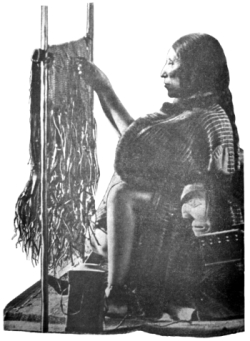Aboriginal American Weaving[1]
—— BY ——
MISS MARY LOIS KISSELL,[2]
American Museum of Natural History,
NEW YORK CITY.
A Paper Read before The National Association of Cotton Manufacturers
at their Eighty-eighth Meeting at Mechanics Fair Building,
Boston, Mass., April 27th, 1910.

ABORIGINAL AMERICAN WEAVING.[3]
Miss Mary Lois Kissell, American Museum of Natural History,New York City.
Wonderful as is the development of modern machinery for themanufacture of American textiles—machinery which seemsalmost human in the way it converts raw materials into finishedcloth; just as surprising are the most primitive looms of theAmerican aborigines, who without the aid of machinery makeinteresting weavings with only a bar upon which to suspend thewarp threads while the human hand completes all the processesof manufacture. Modern man's inventive genius in the textileart has been expended upon perfecting the machinery, whileprimitive man's ingenuity has resulted in making a beautifulweaving with very simple means.
No doubt could we know the history of primitive loom work[4]in America prior to the coming of the white man, we would findan extended distribution of weaving, but all early textiles havebeen lost owing to the destructability of the material and thelack of climatic and other conditions suitable for their preservation—conditionssuch as are present in the hot desert landsof the Southwest and the coast region of Peru. However, somany impressions of weavings have been found on early potteryas to assure us that beautiful work of this kind was made ineastern, middle and southern United States. In western BritishColumbia at the present time there are tribes carrying on certainforms of weaving which show four interesting types.
FIGURE 1.—KWAKIUTL SQUAW, WEAVING.
The simplest type is the cedar bark mat woven of flat strips[5]in horizontal and vertical lines. In beginning wide strips of theinner bark are hung from their centre over a crossbar of woodwhich is supported at either end by an upright beam. Thehalves of the strips hanging in front are then split into strands ofthe desired width and a line of fine twining woven across to holdthem securely. The checker weaving of the mat is now begun atthe left edge by doubling the weft element over the last warp andthen weaving with the doubled element over and under one warpuntil the right edge is reached where it is turned back andslipped under an inch of the weaving just completed. Figure 1shows a squaw at work on such a mat, and when she has completedthis half of the mat the seco
